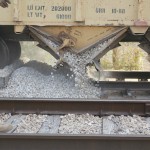LIMESTONE RAILROAD BALLAST

Over 3 million tons of Texas Crushed Stone’s crushed limestone has been used for railroad ballast. Railroad ballast is typically graded from 1 ¾” or 1 ¼” to ½”. Ballast is open graded and washed over a screen as part of the production process.
Railroad Ballast supports the railroad ties. Because ballast is a large one-size, angular rock, it allows water to drain away from the track. The process of placing the ballast around and under the railroad ties and track is called tamping the track. The ballast supports and levels the track. Ballast also helps keep undesirable vegetation from growing in the tracks
The load that rail cars place on the track is large. Each axel on loaded rail car places a load of up to 71,500 lbs. on less than an inch of track. The railroad track structure spreads the load to the ballast below. Because ballast material is angular crushed rock, the crushed ballast locks together as a matrix, which transfers these large loads from track structure to the sub ballast below.
Railroad tracks move as the train passes over the track. A good ballast allows (but restricts) this movement without losing track support. The fact that clean ballast allows water to drain away from the track prevents the track from pumping material from under the track and causing voids under the tracks.
A good ballast is a durable crushed rock. The rock particles have sharp points and are angular in shape. Good ballast is particles of clean crushed rock of nearly all the same size.
The American Association of Railroads has developed specifications for railroad ballast over the last 200 years. Ballast specifications can be found on the AREMA (American Railway Engineering and Maintenance-of-Way Association website. Also, ballast information can be found at wikipedia.org under Track Ballast.